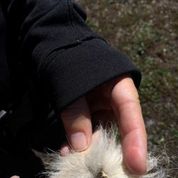WWF is part of a “Students on Ice” expedition from Arctic Canada to Greenland, both sponsoring students, and helping give the students useful skills. WWF staff member Sue Novotny is on board, and is sending blogs about the expedition.
Komaktaviq Fjord, Labrador. Torngat Mountains National Park
Here on the Labrador coast we are seeing and hearing of the mixing of nature that’s beginning to occur with climate change.
First we see signs of polar bears – they’re not showing themselves today but the evidence is everywhere. Within a half hour hike, we come across a napping spot here, some fresh scat there, and a tuft of fur.
In the Torngat Mountains, where the bears far outnumber people, visitors are strongly advised to hire one of the local Inuit bear guards. The guards know the region inside and out, and are experienced in spotting bears, reading their behaviour, and scaring them away long before they can approach a person. Each time we set foot on land, the guards precede us, scouting the hills.
It’s a place that is changing rapidly, says one of the guards from the Torngat base. Armed with a rifle, rubber bullets and a bear banger, he accompanies hikers out on the land all summer long. He’s seeing black bears, moose and more southern birds in greater numbers, ever further north. They’ve also observed polar bears catching fish in much the same way grizzlies do.
With the g uards keeping lookout, we picked our way to the top of a deceptively steep mountain. Happily, neither black bears nor polar bears seem interested in tangling with our group of 130 people.From our vantage point on top of the mountain, we could see for who knows how many kilometres in every direction – but no bears in sight.
uards keeping lookout, we picked our way to the top of a deceptively steep mountain. Happily, neither black bears nor polar bears seem interested in tangling with our group of 130 people.From our vantage point on top of the mountain, we could see for who knows how many kilometres in every direction – but no bears in sight.